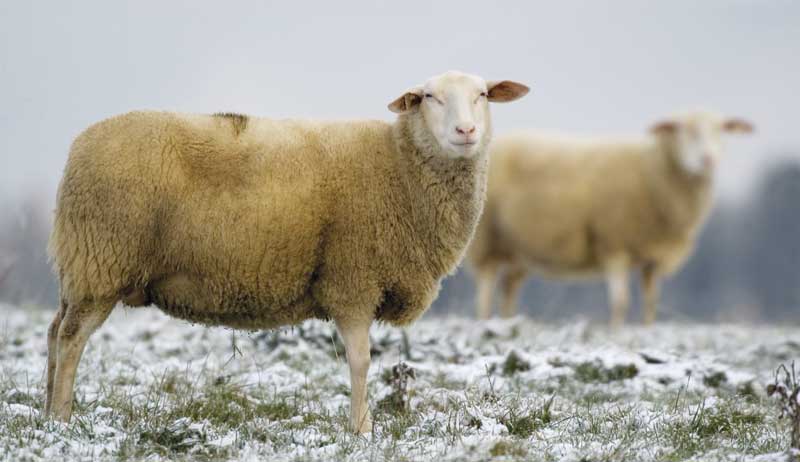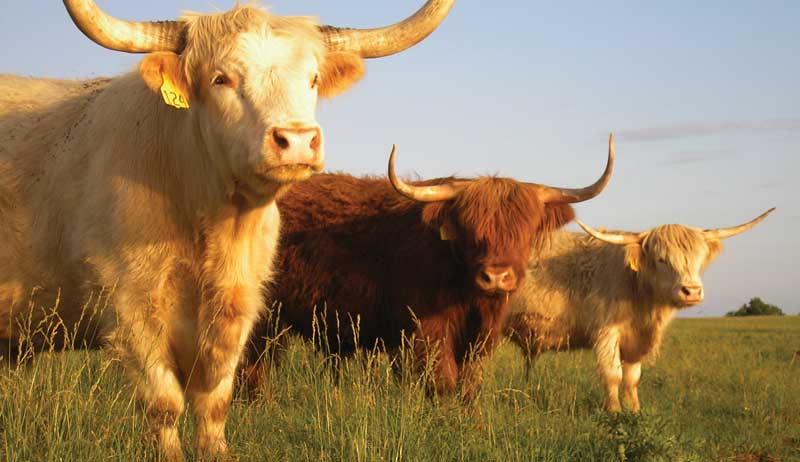
All breeds of livestock were developed for specific purposes. This makes it easy to select livestock breeds suited for the needs of you and your farm. We developed this livestock guide to identify some great breeds for various jobs and situations.
Great Goats
Alpine: A Milk Maven
Some dairy goat breeds produce more milk while others give milk that’s higher in butterfat. The pretty French Alpine, however, is an all-around dairy queen, producing 1 to 1 1/2 or more gallons of 3 1/2 percent butterfat milk per day. Alpines are medium to large goats, smart and agile, and come in a variety of colors and markings.
The Alpine breed is known for its extra-long lactation. This isn’t a goat that peters out after four or five months in milk. In fact, Alpines are noted for their ability to “milk through,” meaning many Alpines can be milked for years without being rebred, a boon for anyone needing fresh milk year-round.
Nigerian Dwarf: A Choice for Cheese
This small but mighty milk producer is no more than 22 1/2 inches tall at the shoulder but produces 1 to 8 pounds of rich, 6 to 10 percent butterfat milk per day, compared with 2 to 6 percent butterfat in the milk of full-size dairy breeds.
High butterfat content makes sweet, creamy, Nigerian Dwarf milk the perfect medium for crafting goat cheese. And because of their sunny dispositions and compact size, Nigerian Dwarfs are easier to house and handle than bigger goats.
Boer: Meat Maven
South African Boer goats came to North America in the early 1990s. Since then, they’ve become America’s premier meat goat. Boers are good-natured and docile and come in a variety of colors including traditional (white with a red or black head), black, red, spotted and dappled.

Boers have long, muscular bodies set on proportionally short legs and sturdy horns that sweep back from the head. Does generally give birth to two to four fast-maturing kids that are capable of gaining 1⁄2 pound per day (and more) through weaning at 3 months of age.
Unlike the other meat goat registries, the organizations that register Boers sanction shows throughout the U.S., making Boers the goat of choice if you like to show.
Colored Angora: Fine for Fiber
This medium-size, friendly, laidback goat grows long, lustrous, wavy locks of mohair fleece as long as 12 inches. It comes in white and colored varieties.
Colored Angoras come in several colors including black (ranging from coal black to silver), fading red and shades of brown. They are generally shorn twice a year when locks are 4 to 6 inches long. Colored Angora fiber is in especially high demand with fiber artists.
Spanish: Good Bet for Brush-Clearing
Christopher Columbus brought Spanish goats to Haiti on his second voyage in 1493. Numerous shipments of Spanish goats soon followed, and some were driven through Florida and onto Mississippi, Alabama and Georgia. Some of those goats escaped to become the feral goats of our American Southwest.
Spanish goats weigh between 50 to 200 pounds. They come in many colors, with multiple types of horns. They are tough, wary and hardy, making the breed America’s first choice among brush- and land-clearing goats. Critically endangered just a few decades ago, heritage Spanish goats are staging a dramatic comeback. They are listed in the Watch category of The Livestock Conservancy’s Conservation Priority List.
Also Read: Consider raising these unusual livestock breeds on your small farm.
Small-Farm Sheep
East Friesian: Dairy Queens
This sheep has more than milk going for it. It is, indeed, a
triple-purpose breed (milk, meat and wool). It hails from East Friesland in northern Germany and the Province of Friesland in the Netherlands, where it emerged as the most productive dairy sheep in the world, producing lactation milk yields of 1,100 to 1,700 pounds for mature ewes.

East Frisians also produce an 8 1/2- to 11-pound, 35- to 37-micron white fleece with an average 5-inch staple and two or three lambs each year. Both sexes are polled and have thin, wool-free fluke tails that don’t require docking.
Icelandic: Marvelous Multipurpose Breed
The Icelandic is another fluke-tailed, triple-purpose sheep. It’s milky enough for home dairying, and it grows a lovely double fleece. An Icelandic fleece is composed of a 4- to 7-pound, 27- to 30-micron, 6- to 8-inch outer layer (called tog) and a 19- to 22-micron, 2- to 4-inch undercoat (thel).
Producers often shear Icelandics twice a year. This breed is grown mostly for meat in Iceland. Here, grass-fed Icelandic lamb commands good prices.
Icelandics come in a wide array of colors and marking patterns, making soft, cushy pelts a lucrative sideline for meat producers. Long-horned ram skulls fetch high prices, too.
Shetland: Best Bet to Make a Sweater
Like Icelandics, the Shetland is a primitive breed, fluke-tailed and double-coated and somewhat smaller than its northern kin. Shetland sheep are fine-boned and agile. Rams weigh just 90 to 125 pounds, and ewes weigh 75 to 100 pounds.
They come in a wide variety of colors, markings and patterns—11 colors and 30 patterns in all. Its fleeces can vary in micron count from around 20 into the 30s. Double coats vary also. Some are more pronounced, while others appear to be single coat. Shetlands are friendly, hardy and easily managed, making them a fine choice for first-time and long-term shepherds.
Also Read: These small livestock breeds are great for hobby farms!
Happy for Hogs
Berkshire: Great for Pulled Pork
Berkshires are noted for especially succulent, mouth-watering meat that is darker red in color than conventional pork. They are hardy and do well in indoor and outdoor situations.
They are fast-maturing, good-natured, easy-to-manage hogs developed in the 1800s for a changing market with a preference for leaner cuts of pork. The American Berkshire Association, established in 1875, gives pedigrees only to pigs directly imported from established English herds or to those tracing directly back to imported animals.
Kunekune: For the Small Farm
Their docile nature makes them the perfect livestock, friendly to people and other farm animals. If raising them for meat, it might take longer as they are slower to mature, but this breed is certainly a first-class porker. It was introduced to New Zealand in the early 1800s, when the Maori people raised this little pig for meat.
This hardy, good-natured pig (pictured above) is also a peerless forager, ideal for raising on pasture by families that prefer small cuts of tasty meat.
It’s a compact, short-legged, short-bodied pig with a short, thick, upturned snout, wattles and small, upright ears. Because of their short, upturned snouts, Kunekunes are poor rooters, so they won’t ruin yards and pastures.
Ossabaw Island Hog: Land-Clearing Champ
Small, feral-looking, heavy-coated and bristly, these pigs have long snouts, heavy shoulders and prick ears fringed with long hair. They descend from swine that Spanish explorers left off the coast of Georgia near Savannah on Ossabaw Island almost 400 years ago.
DNA analysis suggests they originated on the Canary Islands, an important stop by the early explorers en route to the west.
These hardy, self-sufficient pigs like their own space. They produce smaller cuts of well-marbled, juicy meat. For anyone wanting land cleared, long-snouted Ossabaw Island hogs are peerless rooters.
Crazy for Cattle
Miniature Hereford: Splendid for Steaks
These scaled-down versions of full-size Herefords measure 38 to 43 inches at the hip and weigh roughly half what standard Herefords weigh. They’re healthy and hardy and eat roughly 1⁄2 to 1⁄3 as much grass and feed as full-size Herefords.
All the meat from a single steer will fit in an average freezer. Miniature Herefords are just right for most families to feed, butcher and eat within the recommended freezer life of beef.
Highland: Most Unique Appearance
This ancient breed developed via natural selection in the mountainous areas of Scotland. Highlands are short, stocky, long-coated, long-horned with a mop of shaggy hair that covers their eyes. They’re also ideal for producing grass-fed beef.

Highlands are small and compact, docile, extremely cold-hardy and adaptable to any climate conditions. Their beef is lean, well-marbled and delicious, with little outside fat. Fiber artists cherish their downy winter undercoat for hand-spinning purposes.
Whether you want to start raising livestock or add breeds to your small farm, choose a breed that fits your needs. If none of the breeds in this article quite fit what you’re after, check out some other online articles here to learn about additional breeds and how to raise them.
This article originally appeared in the January/February 2023 issue of Hobby Farms magazine.




